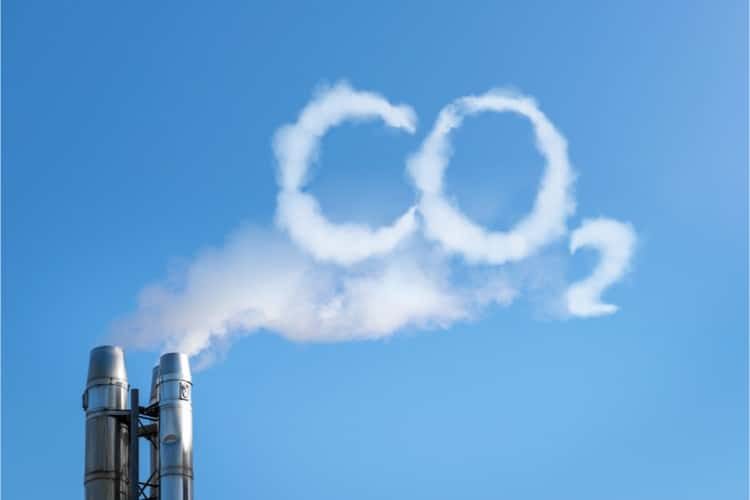
It was in 2013 that an astrobiologist named Jack O’Malley-James warned that life on Earth would eventually end due to a depletion of atmospheric carbon dioxide. Now we’re hearing, also contrary to global warming hand-wringing about excess amounts of the gas posing a danger, that we may one day purposely pump it into our atmosphere as a life-preserving measure.
So says writer Matt Rowe, reporting on Patrick Moore’s book Fake Invisible Catastrophes and Threats of Doom. Moore is an ecologist and ex-Greenpeace figure who left the environmental organization over its embrace of, as he puts it, “anti-human and anti-science campaigns that were more concerned with fundraising and scaring people with mis-information” than with sensible conservationism. Moore has since become a climate-change realist who combats global-warming alarmism.
Writing at American Thinker Monday, Rowe points out that while Moore doesn’t deny that the climate is changing (it always does, naturally), he analyzes matters within a geological-time context. He thus observes that the climate humans have enjoyed for the last 160,000 years is far from the Earth’s norm. In fact, we’re currently in a relatively cold period often known as the Late Cenozoic Ice Age or Antarctic Glaciation. (Presumably quoting Moore, Rowe identifies our current time as the “Pleistocene glacial period”; apparently, experts disagree on the classifications.)
Whatever you call our current age — and we are living within a warmer “interglacial” within it called the Holocene Epoch — “Moore explains that polar bears, undersea reefs, African trees, and other ‘warming threatened’ forms of life on the planet actually thrive in the current climate and there are more diverse species of animal life on Earth right now than during most other eras,” relates Rowe.
Moore “explains in detail that the CO2 level and climate temperature data are not correlated in any way,” the writer continues. “There is a … relationship only if you look from the arbitrary range of data points starting in about 1850 to the present — a mere 170 years.”
Rowe then points out something Boomer sci-fi fans would hear repeatedly on the old Star Trek: We are carbon-based life forms — as is all known life. Carbon is one of the most important elements on our planet and, along with water, is a prerequisite for life’s existence. Rowe then informs:
Moore further discusses how the level of CO2 in our atmosphere is close to an all-time low at some 415 ppm rather than at some unusually high-level that global warming proponents would have us believe. In fact, the CO2 level has been much higher than this during most of the existence of modern life. Considering geological time spans, the Earth’s atmospheric CO2 has been about 2,000 ppm with highs of some 6,000 ppm. It has dropped very low before during the peak of glacial periods. Moore adds that at about 150 ppm plants begin to suffocate.
Now, unsurprisingly, carbon is abundant in our planet. But how does it enter the atmosphere?
It does so, writes Climate.gov via “outgassing from the ocean, decomposing vegetation and other biomass, venting volcanoes, naturally occurring wildfires, and even belches from ruminant animals” — and, of course, due to man’s endeavors.
The volcanic activity, however, is a major factor. As Big Think put it in 2017, “For billions of years, geological processes like volcanic eruptions controlled the carbon concentration in the atmosphere, as volcanism is the major way that carbon rises from the mantle into the atmosphere.” And the “more active the volcanos [sic], the more CO2 in the atmosphere,” Rowe writes.
And why are levels now so low? According to Rowe, again citing Moore, it’s because volcanic eruptions’ frequency has decreased over time. This is because most heat within our planet is generated by the decay of long-lived radioactive elements such as uranium, thorium, radon, and potassium — and, says Rowe, this is what fuels volcanism. Yet this “decay heat has somewhat decreased since the Earth formation, 4 billions [sic] years ago,” writes Radioactivity.eu.com. “Radioactive elements with a shorter lifespan that were present have vanished.” Ergo, reduced volcanism.
At the same time, previously released CO2 is being absorbed. As Rowe explains:
We know that carbon is stored in fossil fuels and in living and dead plants. Did you know that plants and soil contain twice as much carbon as the atmosphere? The ocean holds 45 times the carbon as the atmosphere does. The really surprising thing is that 100 million billion tons of carbon are stored in carbonaceous rocks, such as marble, limestone, and chalk, which are the fossilized remains of ancient sea animals that could make their own protective shells. This is 118,000 times the amount of carbon in the atmosphere. These are all referred to as carbon sinks. Carbon is predominantly being absorbed rather than released into the atmosphere, and this may be the real global threat.
“In geologic thinking, we are perilously close to the lowest levels of atmospheric CO2 that can sustain life as we know it…,” Rowe concludes.
The aforementioned Jack O’Malley-James predicts that the CO2-dearth-induced End Times will come in somewhat less than a billion years. This certainly won’t cause many of us to lose sleep, but it may be “perilously close” geologically speaking.
The point is, states Rowe, that there’s no reason to believe our current CO2 level, 415 ppm, is somehow dangerous when “Mammalian life has lived through millions of years with atmospheric CO2 levels at 2,000 ppm.” In fact, the Earth is greener and crop yields are greater when the gas’ levels are higher, as CO2 facilitates plant growth.
Of course, despite the climate alarmists’ best efforts, they probably won’t succeed in reducing our already low CO2 levels. But this doesn’t mean their propaganda and endeavors have no ill effect. As for just one example, “About two million children below the age of five die from contaminated water every year — about 70 million dead kids since the advent of global warming alarmism,” wrote Principia Scientific International last year. “Bjørn Lomborg [of the Copenhagen Consensus Center] estimates that a fraction of these squandered green energy funds could have put clean water and sanitation systems into every community in the world.”
The point is that the greentopians are right about one thing: resources are limited — this includes financial ones. Squander them on nonsense that only further enriches the pseudo-elites, and there’s less available for the things that really matter.
Lies kill.



